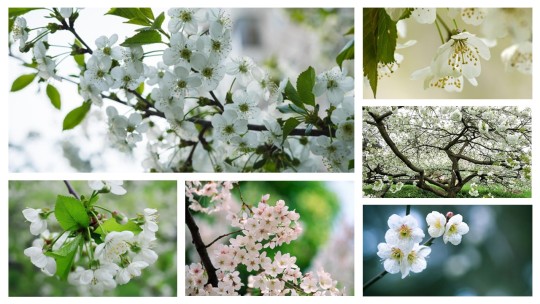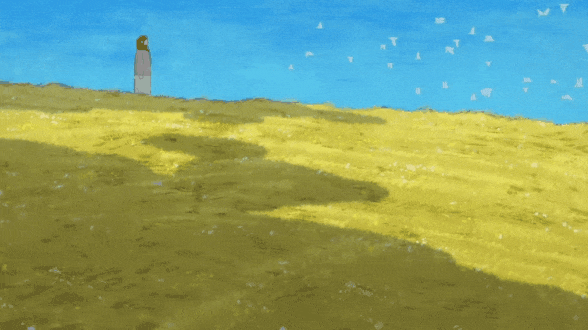#snk ed7
Text
SNK FINAL ED: ITTERASSHAI
HANAKOTOBA ANALYSIS

○●○●○●○●○●○●○●○●○●○●○●○●○●○
-> White Cherry Blossom



White cherry blossoms are the first flower featured in the final ending theme song credits.
The cherry blossom (Prunus serrulata) is also known as the Japanese cherry and is the unofficial national flower of Japan. Its Japanese name Sakura (桜) has been derived from the word “saku” which means “to bloom”. Its meanings in hanakotoba are “beauty of spirit”, grace, chastity, excellent beauty, gentleness, good education and the “transience of life”. In Japan, cherry blossoms are also a symbol of the “beauty of impermanence”—a Shinto concept better known as “mono no aware” (物の哀れ) as their falling petals are a reminder that although life is short, it is beautiful and should be savoured. The Japanese concept of “natsukashi” (懐かしい) likewise emphasizes the fleeting nature of cherry blossoms. This concept refers to the happy-yet-wistful nostalgia for times and things that we will never be able to go back to. We will never get to experience those moments again, just like the ephemeral cherry blossoms, which makes them even more significant. Cherry blossoms bloom from March to April which is the start of the new fiscal year in Japan. As a result of this cherry blossoms have also come to symbolise new beginnings and springtime. Given that feudal Japanese soldiers associated cherry blossoms with honour, discipline, and dignity—falling flowers were thought to be symbolic of a Samurai's death. In Western floriography, cherry blossoms herald the changing of the seasons and symbolise renewal and rebirth. They also symbolise the fleeting nature of life, tenderness, forgiveness, strength, beauty, love, confidence, peace, friendship and gratitude. White cherry blossoms, in particular, represent purity, innocence, and simplicity, as well as hope and rebirth. White cherry blossom blossoms convey joy in the celebration of new beginnings.
“Utsukushiki Zankoku na Sekai” (AOT ED1) depicts a young Mikasa rushing about looking for Eren in a dark, gloomy landscape before shifting into her older self. “Akuma no Ko” (AOT ED7) depicts a young Eren wandering around on his own in a dark cage until he breaks free into a colourful meadow before morphing into his older self. Meanwhile, the final ending, “Itterasshai”, depicts both a young Mikasa and Eren as well as an adult Mikasa and Eren uniting in a field of flowers beneath a picturesque sunset. Given that white cherry blossoms symbolise new beginnings, hope, and rebirth, their inclusion in this montage enhances its depiction of the pair reuniting in the afterlife—effectively tying the first and seventh ending sequences together. Various concepts embodied by the cherry blossom, particularly the transiency of life, mono no aware (the beauty of impermanence), and natsukashi (nostalgia for times and things we can't return to), are also significant themes in Attack on Titan's final arcs, making the flower's placement here appropriate.
-> Red Rose



The next set of flower featured in the final ending sequence are red roses. In Japan, red roses are called benibara (紅薔薇). In hanakotoba roses symbolise love and beauty while red roses in particular symbolize affection and passionate love; while rose thorns represent “happiness in misfortune”. In Western floriography, roses symbolize love, passion, beauty, romance and secrecy. Red roses symbolize enduring passion, desire, affection and romance.
In the visuals for “Itterasshai” four red roses are seen growing alongside a white picket fence. A white bird is later seen flying with a single red rose in its beak. Four red roses are said to symbolise that “nothing will ever come between us”. While a single red rose symbolises love at first sight. This suggests that nothing, not even death, is capable of impacting the pair's feelings for each other and that they have been in love since their first meeting as children. While red roses are an international symbol of romance, passion, devotion and long-lasting love, in some cultures they symbolise sacrifice, martyrdom, bravery, and strength. These qualities embody Eren’s character pretty well.
-> Dandelion


In the above panel, Mikasa holds two dandelion flowers in her hands. Dandelions (Taraxacum) are known as Tanpopo (たんぽぽ) in Japanese. Its meanings in hanakotoba are sincere love, separation and a prophecy of love. Additionally, in English floriography, dandelions represent faithfulness, hope, healing, light and happiness. They also symbolise joy, youthful thoughts, endurance, prosperity and healing.
Given that the dandelion is a symbolic representation of faithfulness, happiness, healing, light, hope and prophecies of love—their use in this ending sequence further reinforces the concept of Mikasa reuniting with Eren in the afterlife.
-> White Daisy


Daisies (Bellis) are known as hinagiku (デイジー) in Japanese, and they hold the hanakotoba meanings of patience, purity, “secret love”, hope, innocence, beauty, peace, and faith. In English floriography, yellow daisies symbolise joy, and growth as well as a turning point or new beginning.
Considering the daisy's symbolic connotations, its usage ending sequence once more accentuates the depiction of the pair finally getting a new start following the events of the series' conclusion. Its meanings of patience, hope, faith and secret love in particular highlight Mikasa going through the rest of her life hoping to be reunited after death.
───●◎●─── P.S. ───●◎●───
-> White Carnation



The flowers Mikasa places by Eren’s grave are the same flowers we see her holding after her passing. These flowers are known as carnations (Dianthus caryophyllus) and are called Kānēshon (カーネーション) in Japanese. Its meanings in hanakotoba are innocent and deep love. White carnations in particular hold the meaning “my love is love” and pure love in Japanese culture. In Western floriography, they symbolise love, fascination and distinction. Carnations are the most popular flower used at weddings in China, while in Korea they express admiration, love and gratitude. Carnations are frequently given as gifts in Japan to convey affection for loved ones or to honour those who have passed away. White carnations, in particular, represent purity and are therefore commonly utilised in ceremonies and rituals.
The meaning of these flowers makes them an excellent choice for this scene and ties well into Mikasa and Eren’s dynamic. The flower’s meaning “my love is alive” perfectly encapsulates Mikasa’s feelings in the aftermath of the series and is a fitting offering for Eren’s gravestone.
○●○●○●○●○●○●○●○●○●○●○●○●○●○
╰┈➤ Attack on Titan ED7 Hanakotoba Analysis
╰┈➤ Anime Hanakotoba Posts Directory
[I wanted to contribute something towards the fandom considering that aot/snk has finally ended but I knew that doing a full-scale review of the episode would be a bad idea. In short, I want to say a lot of things but at the same time, there's nothing I want to say... When I saw the flowers featured in the final ed I knew I had to cover them. If you guys want me to do a Q&A for the show, I'd be willing to... So, feel free to send me questions to answer...
As a side note, I didn't go into a lot of detail here and stuck to focusing on eremika since I've already done a hanakotoba post for snk/aot--where I went into greater depth on the show's general themes.]

#snk#aot#attack on titan#shingeki no kyojin#anime#aot final season#eren yeager#eren jaeger#mikasa ackerman#eremika#eren x mikasa#eren yeager x mikasa ackerman#hanakotoba#snk hanakotoba#aot hanakotoba#anime hanakotoba#hanakotoba analysis#floriography#anime endings#anime ending theme#anime themes#anime music#snk final season#snk eren#snk mikasa#snk itterasshai
64 notes
·
View notes